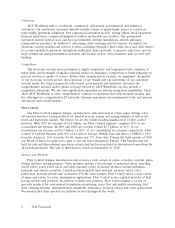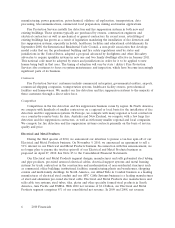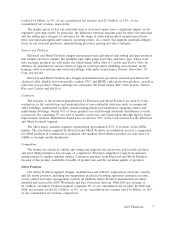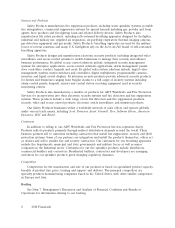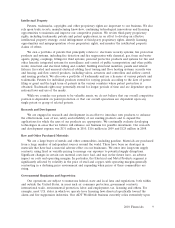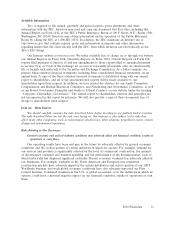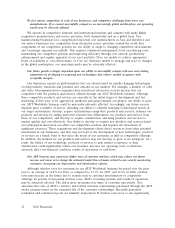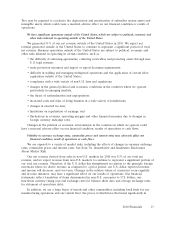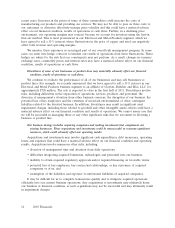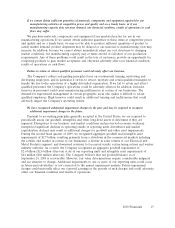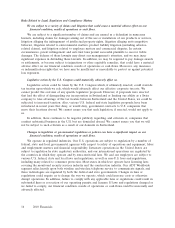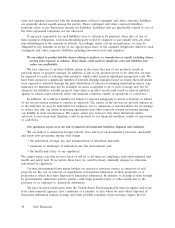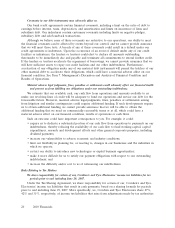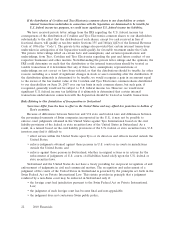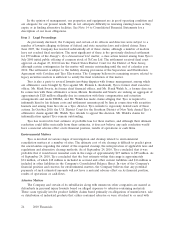ADT 2010 Annual Report Download - page 102
Download and view the complete annual report
Please find page 102 of the 2010 ADT annual report below. You can navigate through the pages in the report by either clicking on the pages listed below, or by using the keyword search tool below to find specific information within the annual report.recent years. Increases in the prices of some of these commodities could increase the costs of
manufacturing our products and providing our services. We may not be able to pass on these costs to
our customers or otherwise effectively manage price volatility and this could have a material adverse
effect on our financial condition, results of operations or cash flows. Further, in a declining price
environment, our operating margins may contract because we account for inventory using the first-in,
first-out method. This is most pronounced in our Electrical and Metal Products segment, which we
have agreed to sell a 51% interest, where fluctuations in the price of copper and steel can negatively
affect both revenue and operating margins.
We monitor these exposures as an integral part of our overall risk management program. In some
cases, we enter into hedge contracts to insulate our results of operations from these fluctuations. These
hedges are subject to the risk that our counterparty may not perform. As a result, changes in currency
exchange rates, commodity prices and interest rates may have a material adverse effect on our financial
condition, results of operations or cash flows.
Divestitures of some of our businesses or product lines may materially adversely affect our financial
condition, results of operations or cash flows.
We continue to evaluate the performance of all of our businesses and may sell businesses or
product lines. For example, we recently announced that we have agreed to sell a 51% interest in our
Electrical and Metal Products business segment to an affiliate of Clayton, Dubilier and Rice, LLC for
approximately $720 million. The sale is expected to close in the first half of 2011. Divestitures involve
risks, including difficulties in the separation of operations, services, products and personnel, the
diversion of management’s attention from other business concerns, the disruption of our business, the
potential loss of key employees and the retention of uncertain environmental or other contingent
liabilities related to the divested business. In addition, divestitures may result in significant asset
impairment charges, including those related to goodwill and other intangible assets, which could have a
material adverse effect on our financial condition and results of operations. We cannot assure you that
we will be successful in managing these or any other significant risks that we encounter in divesting a
business or product line.
Our business strategy includes acquiring companies and making investments that complement our
existing businesses. These acquisitions and investments could be unsuccessful or consume significant
resources, which could adversely affect our operating results.
Acquisitions and investments may involve significant cash expenditures, debt incurrence, operating
losses and expenses that could have a material adverse effect on our financial condition and operating
results. Acquisitions involve numerous other risks, including:
• diversion of management time and attention from daily operations;
• difficulties integrating acquired businesses, technologies and personnel into our business;
• inability to obtain required regulatory approvals and/or required financing on favorable terms;
• potential loss of key employees, key contractual relationships, or key customers of acquired
companies or of us; and
• assumption of the liabilities and exposure to unforeseen liabilities of acquired companies.
It may be difficult for us to complete transactions quickly and to integrate acquired operations
efficiently into our current business operations. Any acquisitions or investments may ultimately harm
our business or financial condition, as such acquisitions may not be successful and may ultimately result
in impairment charges.
14 2010 Financials


